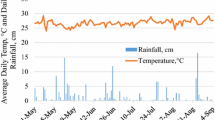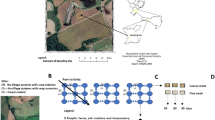Abstract
Crop residues are essential fertilizer source of low-input farming systems in Sub-Saharan Africa. However, crop residues provide nutrients only if they decompose in the soil. Decomposition is assumed to be very low during the dry season due to the scarcity of water, but there are few quantitative knowledge on decomposition under such conditions. Therefore, we studied the decomposition of legume residues, haricot bean (Phaseolus vulgaris L.), and pigeon pea (Cajanus cajan L. (Millps) using litterbag experiments in two coffee and two crop land agroecosystems of southern Ethiopia. The residues were surface applied and subsoil buried under irrigated and non-irrigated conditions and were then retrieved after 30–180 days. We measured mass loss, decay rate constant (k), and C and N concentrations. Results demonstrate an unexpected high decomposition in seasonal dry soils, even when the litterbags were placed on the soil surface. Interestingly, 89 % of the initial N of pigeon pea and 85 % of haricot bean were released after 150 days, on the average. Thus microbial decomposition is unexpectedly high during the dry season. This finding has implications for the effect of plant residues on the supply of mineral N to crops growing during subsequent wet season.





Similar content being viewed by others
References
Abera G, Wolde-meskel E, Bakken LR (2012) Carbon and nitrogen mineralization dynamics in different soils of the tropics amended with legume residues and contrasting soil moisture contents. Biol Fertil Soils 48:51–66. doi:10.1007/s00374-011-0607-8
Abera G, Wolde-meskel E, Bakken LR (2013) Effect of organic residue amendments and soil moisture on N mineralization, maize (Zea mays L.) dry biomass and nutrient concentration. Arch Agron Soil Sci. doi:10.1080/03650340.2012.722623
Adair EC, Patron WJ, Del Grosso SJ, Silver WL, Hall SA, Harmon ME, Hart SC (2008) A simple three pool model accurately describes patterns of long term, global decomposition in the Long-Term Intersite Decomposition Experiment Team (LIDET) data set. Glob Chang Biol 14:2636–2660. doi:10.1111/j.1365-2486.2008.01674.x
Anderson JM, Ingram JI (1993) Tropical soil biology and fertility—a handbook of methods, 2nd edn. CAB International, Wallingford
Arunachalam A, Singh ND (2004) Decomposition of Mesua ferrera litter in humid tropics Arunachal Pradesh, India. J Trop For Sci 16:151–159
Asgharipou MR, Rafiei M (2011) The effects of land use on biomass and catabolic diversity of soil microbial communities. Afr J Agric Res 6:4607–4612. doi:10.5897/AJAR11.1160
Austin AT, Viousek PM (2000) Precipitation, decomposition and litter decomposability of Metrosideros polymorpha in native forests on Hawai'i. J Ecol 88:129–138
Austin AT, Vivanco L (2006) Plant litter decomposition in a semi-arid ecosystem controlled by photodegradation. Nat Lett 442:555–558. doi:10.1038/nature05038
Borgen S, Molstad L, Bruun S, Breland TA, Bakken LR, Bleken MA (2011) Estimation of plant litter pools and decomposition-related parameters in a mechanistic model. Plant Soil 338:205–222. doi:10.1007/s11104-010-0404-4
Coppens F, Garnier P, Findeling A, Merckx R, Recous S (2007) Decomposition of mulched versus incorporated crop residues: modelling with PASTIS clarifies interactions between residue quality and location. Soil Biol Biochem 39:2339–2350. doi:10.1016/j.soilbio.2007.04.005
Coûteaux M-M, Bottner P, Berg B (1995) Litter decomposition, climate and litter quality. Rev TREE 10:63–66
Cusack D, Chou W, Yang W, Harmon M, Silver W, the LIDET Team (2009) Controls on long-term root and leaf litter decomposition in Neotropical forests. Glob Chang Biol 15:1339–1355. doi:10.1111/j.1365-2486.2008.01781.x
Dubeux JCB Jr, Sollenberger LE, Interrante SM, Vendramini JMB Jr, RLS (2006) Litter decomposition and mineralization in bahiagrass pastures managed at different intensities. Crop Sci 46:1305–1310. doi:10.2135/cropsci2005.08-0263
Ehaliotis C, Cadisch G, Giller KE (1998) Substrate amendments can alter microbial dynamics and N availability from maize residues to subsequent crops. Soil Biol Biochem 30:1281–1292
FAO (1998) World Reference Base for Soil Resources. World Soil Resources Reports 84. Food and Agricultural Organization of the United Nations, Rome
Henriksen TM, Breland TA (2002) Carbon mineralization, fungal and bacterial growth, and enzyme activities as affected by contact between crop residues and soil. Biol Fertil Soils 35:41–48. doi:10.1007/s00374-001-0438-0
Kurz-Besson C, Coûteaux M-M, Thie'ry JM, Berg B, Remacl J (2005) A comparison of litterbag and direct observation methods of Scots pine needle decomposition measurement. Soil Biol Biochem 3:2315–2318. doi:10.1016/j.soilbio.2005.03.022
Landon JR (1991) Booker tropical soil manual: a handbook for soil survey and agricultural land evaluation in the tropics and subtropics. Longman, London, p 532
Magid J, De Neergaard A, Brant M (2006) Heterogeneous distribution may substantially decrease initial decomposition, long-term microbial growth and N-immobilization from high C–N ratio resources. Eur J Soil Sci 57:517–529
Odhiambo JJO (2010) Decomposition and nitrogen release by green manure legume residues in different soil types. Afr J Agric Res 5:090–096. doi:10.5897/AJAR09.489
Palm CA, Gachengo CN, Delve RJ, Cadisch G, Giller KE (2001) Organic inputs for soil fertility management in tropical agro-ecosystems: application of an organic resource database. Agric Ecosyst Environ 83:27–42
Pouyat RV, Carreiro MM (2003) Controls on mass loss and nitrogen dynamics of oak leaf litter along an urban–rural land-use gradient. Oecologia 135:288–298. doi:10.1007/s00442- 003-1190-y
Sakala WD, Cadisch G, Giller KE (2000) Interactions between residues of maize and pigeon pea and mineral N fertilizers during decomposition and N mineralization. Soil Biol Biochem 32:679–688
Salinas N, Malhi Y, Meir P, Silman M, Cuesta RR, Huaman J, Salinas D, Huaman V, Gibaja A, Mamani M, Farfan F (2011) The sensitivity of tropical leaf litter decomposition to temperature: results from a large-scale leaf translocation experiment along an elevation gradient in Peruvian forests. New Phytol 189:967–977. doi:10.1111/j.1469-8137.2010.03521.x
Sierra J (2002) Nitrogen mineralization and nitrification in a tropical soil: effects of fluctuating temperature conditions. Soil Biol Biochem 34:1219–1226
Singh KP, Singh PK, Tripathi SK (1999) Litter fall, litter decomposition and nutrient release patterns in four native tree species raised on coal mine spoil at Singrauli, India. Biol Fertil Soils 29:371–378
Tateno R, Tokuchi N, Yamanaka N, Du S, Otsuki K, Shimamura T, Xu Z, Wang S, Hou Q (2007) Comparison of leaf litter production and leaf litter decomposition between an exotic black locust plantation and an indigenous oak forest near Yan’an on the Loess Plateau, China. Forest Ecol Manage 24:84–90. doi:10.1016/j.foreco.2006.12.026
Teklay T (2007) Decomposition and nutrient release from pruning residues of two indigenous agroforestry species during the wet and dry seasons. Nutr Cycl Agroecosyst 77:115–126. doi:10.1007/s10705-006-9048-4
Tian G, Badeji MA, Okoh AI, Ishida F, Kolawole GO, Hayashi Y, Salako FK (2007) Effect of residue quality and climate on plant residue decomposition and nutrient release along the transect from humid forest to Sahel of West Africa. Biogeochemistry 86:217–229. doi:10.1007/s10533-007-9158-3
Virzo De Santo A, Berg B, Rutigliano FA, Alfani A, Fioretto A (1993) Factors regulating early-stage decomposition of needle litters in five different coniferous forests. Soil Biol Biochem 25:1423–1433
Yohannes Y, Shibistova O, Abate A, Fetene M, Guggenberger G (2011) Soil CO2 efflux in an Afromontane forest of Ethiopia as driven by seasonality and tree species. Forest Ecol Manage 261:1090–1098. doi:10.1016/j.foreco.2010.12.03
Zeng DH, Mao R, Chang SX, Li LJ, Yang D (2010) Carbon mineralization of tree leaf litter and crop residues from poplar-based agroforestry systems in Northeast China: a laboratory study. Appl Soil Ecol 44:133–137. doi:10.1016/j.apsoil.2009.11.002
Zhang D, Hui D, Luo Y, Zhou G (2008) Rates of litter decomposition in terrestrial ecosystems: global patterns and controlling factors. J Plant Ecol 1:85–93. doi:10.1093/jpe/rtn002
Acknowledgments
We cordially acknowledge the Norwegian Program for Development, Research and Higher Education (NUFU) for funding this research work via legume-rhizobia collaborative project with Hawassa University. The laboratory facilities provided by the School of Plant and Horticultural Sciences of Hawassa University and the assistance offered by Mr. Solomon Yigerem and Samson Henta during the process of field establishment of the experiments and data generation are also duly acknowledged.
Author information
Authors and Affiliations
Corresponding author
About this article
Cite this article
Abera, G., Wolde-Meskel, E. & Bakken, L.R. Unexpected high decomposition of legume residues in dry season soils from tropical coffee plantations and crop lands. Agron. Sustain. Dev. 34, 667–676 (2014). https://doi.org/10.1007/s13593-013-0172-7
Accepted:
Published:
Issue Date:
DOI: https://doi.org/10.1007/s13593-013-0172-7




